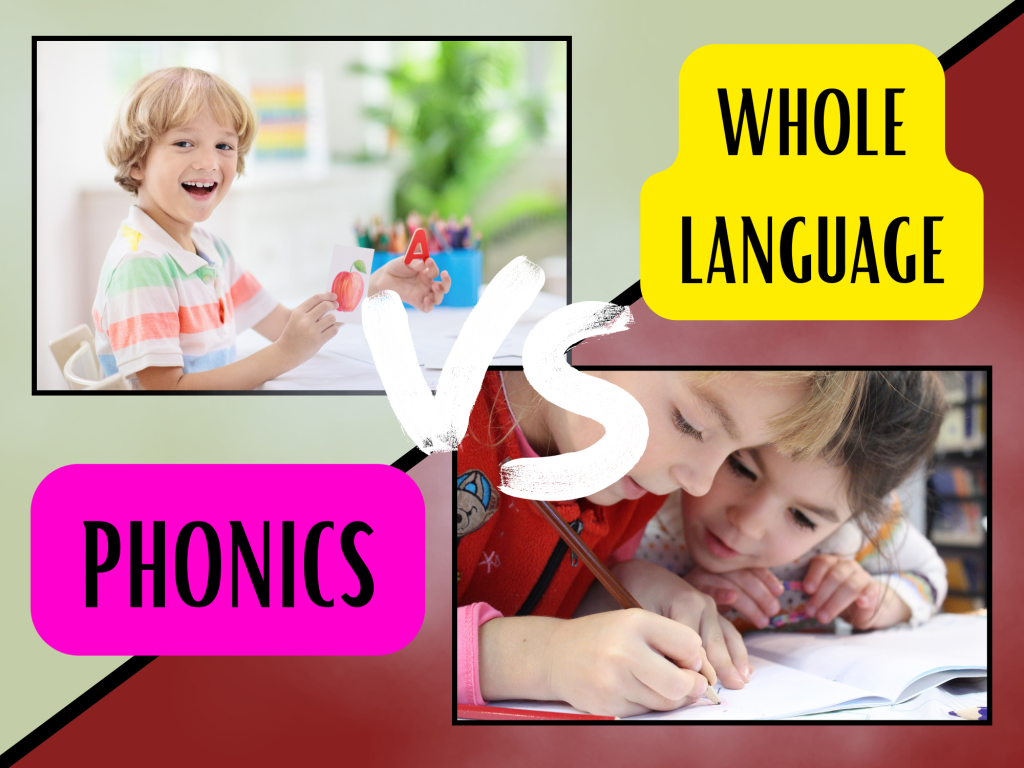At Kids book club HQ, we understand the importance of providing parents and educators with valuable insights into the world of education. When it comes to teaching children to read, there has been an ongoing debate about the most effective method: phonics vs. whole language. In this comprehensive article, we will explore the intricacies of both approaches and help you determine which one may be the superior reading method for kids.
Phonics vs. whole language: Table of contents

Phonics: The Foundation of Reading Skills
Phonics is a method that focuses on teaching children to read by breaking down words into their individual sounds, or phonemes, and then blending those sounds together to form words. This approach emphasizes the relationship between letters and their corresponding sounds. Here are some key points to consider:
1. The Importance of Phonemic Awareness
Phonemic awareness, the ability to hear and manipulate individual sounds in words, is a crucial skill for early readers. Phonics instruction helps children develop this skill, which is essential for decoding words.
If you would like to learn more about how to use phonics, this post may help you:THE ULTIMATE GUIDE FOR TEACHING PHONICS TO CHILDREN!
2. Building Strong Spelling and Pronunciation Skills
Phonics lays the foundation for correct spelling and pronunciation. By learning the sounds of letters and letter combinations, children can more easily decipher unfamiliar words and improve their overall reading comprehension.
3. Systematic and Sequential Learning
Phonics instruction typically follows a systematic and sequential approach, starting with basic letter-sound relationships and progressing to more complex phonics rules. This structured learning helps children build a solid reading foundation.
4. Phonics-Based Resources
Numerous phonics-based resources, such as phonics workbooks, flashcards, and interactive apps, are readily available to support educators and parents in teaching children to read effectively.
check out this blog if you would like to learn more: FUN PHONICS GAMES AND ACTIVITIES FOR KIDS: EXPLORE NOW!
Need help finding some good phonics books? Check out these blogs:

Whole Language: A Holistic Approach to Reading
Whole language, on the other hand, takes a holistic approach to reading instruction. It emphasizes the use of context and meaning to understand words and texts. Here are some key aspects of whole language:
1. Reading for Meaning
Whole language advocates argue that reading should focus on comprehension and meaning rather than isolated phonics instruction. It encourages children to make connections between the text and their own experiences.
2. Literature-Rich Environment
Whole language programs often involve exposing children to a wide range of literature and encouraging them to explore books independently. This immersion in reading material is believed to foster a love of reading.
3. Encouraging Writing and Expression
Whole language instruction often incorporates writing and creative expression as integral components of literacy development. Children are encouraged to write their own stories and journals.
4. Balancing Act
Proponents of whole language acknowledge the importance of phonics but argue that it should be integrated naturally into the reading process rather than taught in isolation.
Phonics: Unlocking the Code of Language
Pros
- Strong Foundation: Phonics provides children with a solid foundation in decoding words by teaching them the relationship between letters and sounds. This skill is essential for independent reading.
- Improved Spelling: Phonics instruction typically leads to better spelling skills since children learn to associate sounds with specific letter combinations, reducing spelling errors.
- Decoding Abilities: Phonics equips children with the ability to decode unfamiliar words by breaking them down into manageable phonetic components, enhancing overall reading comprehension.
- Structured Approach: Phonics instruction follows a systematic, step-by-step approach that makes it easy for both teachers and parents to track a child’s progress.
Cons
- Can Be Overwhelming: Some children may find phonics overwhelming, especially if they struggle with blending sounds or have difficulty memorizing phonetic rules.
- Lacks Emphasis on Comprehension: Critics argue that phonics places too much focus on decoding words and not enough on understanding the meaning of the text, potentially hindering overall comprehension.
- Monotonous for Some: For children who thrive on creativity and holistic learning, the repetitive nature of phonics instruction may become tedious.
- Not Suitable for All: Phonics may not be the best fit for children with certain learning disabilities or for those who benefit from a more holistic, meaning-based approach.
Whole Language: Reading with Context and Meaning
Pros
- Promotes Love of Reading: Whole language encourages a love for reading by immersing children in a literature-rich environment, fostering a genuine interest in books.
- Comprehension-Oriented: Whole language prioritizes understanding the meaning of text, helping children develop strong comprehension skills from an early age.
- Flexible and Creative: This approach allows for flexibility in learning, catering to various learning styles. It encourages creative expression through writing and storytelling.
- Real-Life Application: Whole language mirrors how reading is used in everyday life, making it more relevant and relatable for children.
Cons
- Spelling and Decoding Challenges: Critics argue that whole language may not adequately equip children with the necessary phonetic skills for accurate spelling and decoding.
- Varied Outcomes: The effectiveness of whole language can vary widely depending on the teacher’s implementation and the child’s individual learning style, leading to inconsistent outcomes.
- Lack of Structure: Some children may struggle in the absence of a structured approach, as they might not receive clear guidance on letter-sound relationships.
- Potential Gaps: In some cases, whole language instruction may result in gaps in a child’s phonics skills, which could pose challenges when encountering unfamiliar words.
Comparative Analysis
1. Phonics vs. Whole Language: A Balanced Approach
- Phonics: Strengthens foundational reading skills.
- Whole Language: Fosters a love for reading and comprehension.
- Balanced Approach: Combines the strengths of both methods.
2. Phonics vs. Whole Language: Tailoring to Individual Needs
- Phonics: Ideal for children who benefit from structured learning and phonetic rules.
- Whole Language: Appeals to creative learners who thrive on holistic, context-rich experiences.
- Balanced Approach: Adapts to the child’s unique learning style, ensuring a well-rounded education.
3. Phonics vs. Whole Language: Spelling and Decoding
- Phonics: Provides a strong foundation for accurate spelling and decoding.
- Whole Language: May result in spelling and decoding challenges for some children.
- Balanced Approach: Addresses both phonetic and holistic aspects, minimizing potential gaps.
Phonics Approach Statistics
| Aspect | Statistics |
|---|---|
| Strong Foundation | According to NAEP, phonics instruction leads to better reading performance in students. |
| Improved Spelling | Research by the International Literacy Association shows improved spelling accuracy in young readers with phonics-based programs. |
| Decoding Abilities | A study in the Journal of Educational Psychology indicates that phonics positively impacts decoding abilities, leading to increased reading comprehension. |
| Structured Approach | The U.S. Department of Education analysis demonstrates that structured phonics programs consistently yield positive outcomes in reading development. |
Whole Language Approach Statistics
| Aspect | Statistics |
|---|---|
| Promotes Love of Reading | Research in the Journal of Literacy Research suggests that children exposed to a wide range of literature from a young age are more likely to develop a lifelong reading habit. |
| Comprehension-Oriented | Research from the American Educational Research Journal demonstrates that whole language programs positively impact students’ comprehension abilities. |
Which Method is Superior?
Now that we have explored both phonics vs. whole language, it’s important to recognize that the superiority of one method over the other is a matter of ongoing debate among educators.
Consider Individual Needs
The effectiveness of either method can vary depending on individual children’s needs, learning styles, and abilities. Some children may thrive with a strong phonics-based approach, while others may benefit from the holistic nature of whole language.
Balanced Approach
Many educators advocate for a balanced approach. Not phonics vs. whole language, but Phonics and whole language. This approach aims to provide children with a well-rounded literacy education that combines the strengths of both methods.
Parental Involvement
Parents play a crucial role in supporting their child’s reading development. Regardless of the method chosen, reading regularly with your child, providing access to a variety of books, and creating a positive reading environment are key factors in fostering literacy skills.
These statistics provide valuable insights into the effectiveness of phonics and whole language approaches in developing essential reading skills.
Related Blogs Throughout the Article
- THE ULTIMATE GUIDE FOR TEACHING PHONICS TO CHILDREN!
- FUN PHONICS GAMES AND ACTIVITIES FOR KIDS: EXPLORE NOW!
- MONTHLY READING CHALLENGES FOR KIDS: MUST READ NOW!!
- BEST PHONICS APPS FOR KIDS TO HELP WITH READING
- HOW CAN PHONICS FOR READING CHANGE A CHILD’S LIFE? CLICK NOW
Conclusion to Phonics vs. Whole language
The choice between phonics vs. whole language is not a one-size-fits-all decision. Each method has its own set of advantages and drawbacks. To make the best choice for your child, consider their individual learning style, strengths, and weaknesses. A balanced approach that incorporates elements of both phonics and whole language can often provide the most comprehensive reading education.
At Kids book club HQ, we are committed to providing you with valuable insights to empower your child’s education journey. Whether you choose phonics, whole language, or a balanced approach, remember that fostering a love of reading is the ultimate goal.
Join the Community
Are you eager to become a part of our thriving educational community? You’ve come to the right place! Here, we encourage active participation and engagement. Let’s embark on this journey together.
Follow Us on Pinterest
Start by following us on Pinterest. Our boards are brimming with educational inspiration, from teaching tips to creative activities for kids. It’s a great way to stay updated with our latest ideas.
Read Other Blogs
Dive into our treasure trove of blogs. Read other insightful articles that cover a wide range of topics, from phonics to reading challenges. Explore the wealth of knowledge our community has to offer.
Leave a Comment
Your voice matters to us. Share your thoughts, experiences, and questions by leaving a comment on our blogs. We love hearing from our readers, and your input can spark engaging discussions.
Subscribe to the Blog
Don’t miss a single update. Subscribe to our blog and receive notifications of new posts directly in your inbox. Stay informed about the latest trends in education and child development.
Joining our community is a simple yet rewarding step towards enhancing your child’s education and your own teaching journey. We look forward to having you as a valued member of our educational family!


Pingback: Discover the Best Phonics Books for Kids -